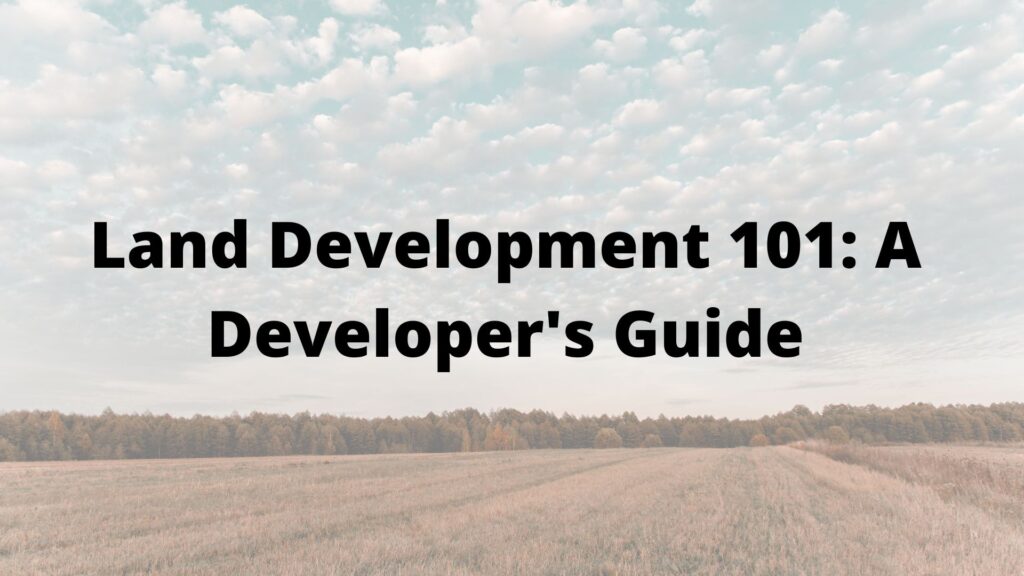
Florida, with its booming population, desirable climate, and diverse landscapes, presents both immense opportunities and unique challenges for land developers. Whether you’re envisioning a sprawling suburban community or a carefully planned rural development, understanding the intricacies of Florida’s land development process is crucial for success. This guide will walk you through the pros and cons, as well as the essential ins and outs of land development in the Sunshine State.
The Allure of Florida: Pros of Land Development
- High Demand: Florida consistently ranks among the fastest-growing states in the nation (U.S. Census Bureau). This influx of residents fuels a strong demand for new housing, commercial spaces, and infrastructure in both suburban and even previously rural areas.
- Economic Growth: Development projects contribute significantly to the local economy through job creation, increased tax revenue, and the attraction of new businesses (Florida Department of Economic Opportunity). This can lead to a positive feedback loop, further enhancing the desirability of the developed areas.
- Diverse Opportunities: Florida’s varied geography offers a wide range of development possibilities, from waterfront properties and golf course communities to agricultural lands ripe for transformation and infill projects in existing urban areas. This allows developers to cater to diverse market segments.
- Relatively Favorable Regulatory Environment (in some aspects): While regulations exist, Florida generally has a streamlined permitting process compared to some other states, particularly concerning certain types of development. However, this varies significantly depending on location and project scope (Florida Department of Environmental Protection).
Navigating the Challenges: Cons of Land Development
- Environmental Sensitivity: Florida’s unique ecosystems, including wetlands, coastal areas, and endangered species habitats, necessitate stringent environmental regulations. Obtaining permits can be complex and time-consuming, often requiring extensive environmental impact studies (Florida Department of Environmental Protection).
- Water Management: Water scarcity and quality are critical concerns in Florida. Developers must navigate complex water use regulations, stormwater management requirements, and potential limitations on water availability, particularly in certain regions (South Florida Water Management District).
- Hurricane Risk and Climate Change: Florida’s vulnerability to hurricanes and the impacts of climate change, such as sea-level rise, present significant risks. Building codes and insurance requirements reflect these realities, adding to development costs and complexities (Florida Division of Emergency Management).
- Infrastructure Limitations: Rapid growth can strain existing infrastructure, including roads, utilities, and schools. Developers may be required to contribute significantly to infrastructure upgrades, impacting project costs and timelines (Local County and City Planning Departments).
- Community Opposition: Development projects can face opposition from local residents concerned about traffic, environmental impacts, and changes to the character of their communities. Effective communication and community engagement are crucial for navigating these challenges.
The Ins and Outs: Key Aspects of Land Development in Florida
- Due Diligence and Site Analysis: Thoroughly investigate the property’s zoning regulations, comprehensive plan designation, environmental constraints (wetlands, protected species), soil conditions, and access to utilities. Engage environmental consultants, surveyors, and legal counsel early in the process.
- Permitting and Approvals: Navigate the multi-layered permitting process involving local, regional, and state agencies. This includes zoning approvals, site plan reviews, environmental permits (e.g., wetlands permits from the Army Corps of Engineers and the Florida Department of Environmental Protection), building permits, and concurrency approvals (ensuring adequate infrastructure capacity).
- Comprehensive Planning: Understand the local government’s comprehensive plan, which outlines the long-term vision for growth and development within its jurisdiction (Florida Department of Economic Opportunity). Development proposals must be consistent with the comprehensive plan.
- Concurrency: Florida’s concurrency requirements mandate that necessary infrastructure (roads, water, sewer, schools, parks) must be in place or planned to be in place concurrent with the impacts of new development (Florida Statutes, Chapter 163, Part II).
- Environmental Regulations: Be prepared to address stringent environmental regulations related to wetlands protection, stormwater management, endangered species, and coastal zone management. Mitigation measures or off-site mitigation may be required to offset environmental impacts.
- Water and Wastewater: Secure necessary water use permits and plan for adequate water and wastewater infrastructure. Coordinate with local utilities or consider developing independent systems.
- Stormwater Management: Implement effective stormwater management systems to control runoff, prevent flooding, and protect water quality, adhering to regulations set by the Florida Department of Environmental Protection and local governments.
- Community Engagement: Engage with local communities early and often to address concerns, build support, and ensure a smoother development process. Public hearings and community meetings are often required.
- Financing: Secure adequate financing for land acquisition, permitting, infrastructure development, and construction. Understand the specific requirements and risks associated with Florida’s real estate market.
Rural vs. Suburban Development:
- Rural Development: Often involves larger tracts of land, potentially lower initial land costs, and a focus on preserving rural character. However, it can face challenges related to infrastructure availability (water, sewer, roads), greater scrutiny regarding environmental impacts, and potentially longer approval timelines. Zoning regulations in rural areas may also be less defined, requiring more negotiation with local authorities.
- Suburban Development: Typically focuses on creating residential communities, commercial centers, or mixed-use developments within or adjacent to existing urban areas. Infrastructure is generally more readily available, but land costs are higher, and projects may face more intense community scrutiny regarding traffic, density, and impact on existing services. Infill development within established suburbs presents its own set of challenges and opportunities.
Land development in Florida offers significant opportunities for those who are well-prepared and understand the state’s unique regulatory landscape, environmental sensitivities, and market dynamics. By carefully considering the pros and cons, diligently navigating the permitting process, and engaging effectively with communities and regulatory agencies, developers can successfully contribute to Florida’s growth while creating sustainable and thriving spaces. Thorough due diligence and expert guidance are essential to navigate the complexities and capitalize on the potential of land development in the Sunshine State.
 John Caravella Esq., is a construction attorney and formerly practicing project architect at The Law Office of John Caravella, P.C., representing architects, engineers, contractors, subcontractors, and owners in all phases of contract preparation, litigation, and arbitration across New York and Florida. He also serves as an arbitrator to the American Arbitration Association Construction Industry Panel. Mr. Caravella can be reached by email: [email protected] or (631) 608-1346.
John Caravella Esq., is a construction attorney and formerly practicing project architect at The Law Office of John Caravella, P.C., representing architects, engineers, contractors, subcontractors, and owners in all phases of contract preparation, litigation, and arbitration across New York and Florida. He also serves as an arbitrator to the American Arbitration Association Construction Industry Panel. Mr. Caravella can be reached by email: [email protected] or (631) 608-1346.
The information provided on this website does not, and is not intended to, constitute legal advice; instead, all information, content, and materials available on this site are for general informational purposes only. Readers of this website should contact their attorney to obtain advice with respect to any particular legal matter. No reader, user, or browser of this site should act or refrain from acting on the basis of information on this site without first seeking legal advice from counsel in the relevant jurisdiction. Only your individual attorney can provide assurances that the information contained herein – and your interpretation of it – is applicable or appropriate to your particular situation. Use of, and access to, this website or any of the links or resources contained within the site do not create an attorney-client relationship between the reader, user, or browser and website authors, contributors, contributing law firms, or committee members and their respective employers.
Resources:
- S. Census Bureau: [Insert Link to U.S. Census Bureau Website]
- Florida Department of Economic Opportunity: [Insert Link to Florida DEO Website]
- Florida Department of Environmental Protection: [Insert Link to Florida DEP Website]
- South Florida Water Management District: [Insert Link to SFWMD Website (or relevant water management district)]
- Florida Division of Emergency Management: [Insert Link to Florida DEM Website]
- Florida Statutes, Chapter 163, Part II (Local Government Comprehensive Planning Act): [Insert Link to relevant Florida Statutes]
- Local County and City Planning Departments: [Links will vary depending on specific locations]
